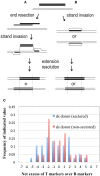Heteroduplex formation, mismatch resolution, and genetic sectoring during homologous recombination in the hyperthermophilic archaeon sulfolobus acidocaldarius
- PMID: 22679441
- PMCID: PMC3367456
- DOI: 10.3389/fmicb.2012.00192
Heteroduplex formation, mismatch resolution, and genetic sectoring during homologous recombination in the hyperthermophilic archaeon sulfolobus acidocaldarius
Abstract
Hyperthermophilic archaea exhibit certain molecular-genetic features not seen in bacteria or eukaryotes, and their systems of homologous recombination (HR) remain largely unexplored in vivo. We transformed a Sulfolobus acidocaldariuspyrE mutant with short DNAs that contained multiple non-selected genetic markers within the pyrE gene. From 20 to 40% of the resulting colonies were found to contain two Pyr(+) clones with distinct sets of the non-selected markers. The dual-genotype colonies could not be attributed to multiple DNAs entering the cells, or to conjugation between transformed and non-transformed cells. These colonies thus appear to represent genetic sectoring in which regions of heteroduplex DNA formed and then segregated after partial resolution of inter-strand differences. Surprisingly, sectoring was also frequent in cells transformed with single-stranded DNAs. Oligonucleotides produced more sectored transformants when electroporated as single strands than as a duplex, although all forms of donor DNA (positive-strand, negative-strand, and duplex) produced a diversity of genotypes, despite the limited number of markers. The marker patterns in the recombinants indicate that S. acidocaldarius resolves individual mismatches through un-coordinated short-patch excision followed by re-filling of the resulting gap. The conversion events that occur during transformation by single-stranded DNA do not show the strand bias necessary for a system that corrects replication errors effectively; similar events also occur in pre-formed heteroduplex electroporated into the cells. Although numerous mechanistic details remain obscure, the results demonstrate that the HR system of S. acidocaldarius can generate remarkable genetic diversity from short intervals of moderately diverged DNAs.
Keywords: gene conversion; genetic transformation; linear DNA; mismatch repair.
Figures








Similar articles
-
How a Genetically Stable Extremophile Evolves: Modes of Genome Diversification in the Archaeon Sulfolobus acidocaldarius.J Bacteriol. 2017 Aug 8;199(17):e00177-17. doi: 10.1128/JB.00177-17. Print 2017 Sep 1. J Bacteriol. 2017. PMID: 28630130 Free PMC article.
-
Discontinuity and limited linkage in the homologous recombination system of a hyperthermophilic archaeon.J Bacteriol. 2010 Sep;192(18):4660-8. doi: 10.1128/JB.00447-10. Epub 2010 Jul 19. J Bacteriol. 2010. PMID: 20644140 Free PMC article.
-
Homologous recombination in the archaeon Sulfolobus acidocaldarius: effects of DNA substrates and mechanistic implications.Microbiology (Reading). 2013 Sep;159(Pt 9):1888-1899. doi: 10.1099/mic.0.067942-0. Epub 2013 Jul 7. Microbiology (Reading). 2013. PMID: 23832004
-
Homologous recombination in Sulfolobus acidocaldarius: genetic assays and functional properties.Biochem Soc Trans. 2009 Feb;37(Pt 1):88-91. doi: 10.1042/BST0370088. Biochem Soc Trans. 2009. PMID: 19143608 Review.
-
Mismatch repair and the fidelity of genetic recombination.Genome. 1989;31(1):68-73. doi: 10.1139/g89-014. Genome. 1989. PMID: 2687108 Review.
Cited by
-
The modern "3G" age of archaeal molecular biology.Front Microbiol. 2012 Dec 20;3:430. doi: 10.3389/fmicb.2012.00430. eCollection 2012. Front Microbiol. 2012. PMID: 23267357 Free PMC article. No abstract available.
-
Lesion-Induced Mutation in the Hyperthermophilic Archaeon Sulfolobus acidocaldarius and Its Avoidance by the Y-Family DNA Polymerase Dbh.Genetics. 2015 Oct;201(2):513-23. doi: 10.1534/genetics.115.178566. Epub 2015 Jul 29. Genetics. 2015. PMID: 26224736 Free PMC article.
-
Understanding DNA Repair in Hyperthermophilic Archaea: Persistent Gaps and Other Reasons to Focus on the Fork.Archaea. 2015 Jun 4;2015:942605. doi: 10.1155/2015/942605. eCollection 2015. Archaea. 2015. PMID: 26146487 Free PMC article. Review.
-
How a Genetically Stable Extremophile Evolves: Modes of Genome Diversification in the Archaeon Sulfolobus acidocaldarius.J Bacteriol. 2017 Aug 8;199(17):e00177-17. doi: 10.1128/JB.00177-17. Print 2017 Sep 1. J Bacteriol. 2017. PMID: 28630130 Free PMC article.
References
LinkOut - more resources
Full Text Sources
Miscellaneous

